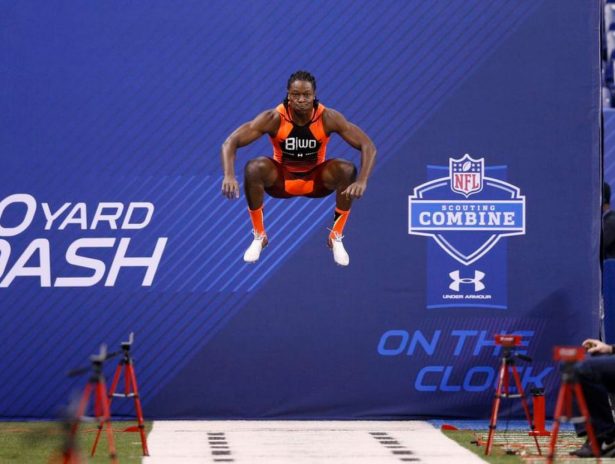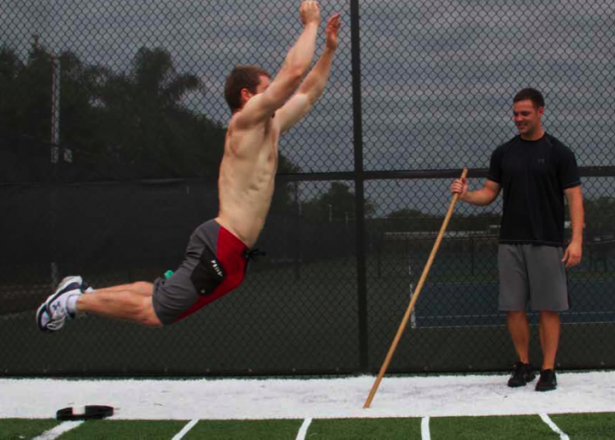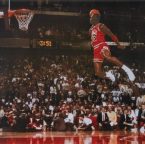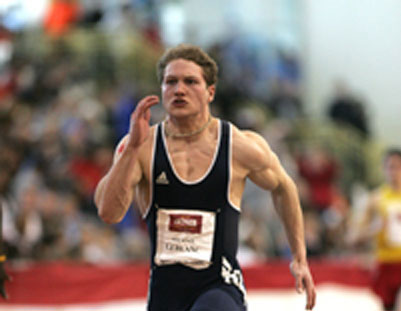In my latest article, I talked about why box jumps don’t hold as much value as we think they do. Sure, jumping onto a high box does have some benefits but the risk-to-reward ratio is not that great. There are many other ways to improve power, explosiveness, and deceleration, build muscle and burn fat.
That being said, plyometrics do have their place in many different strength and conditioning programs. When done correctly, they can help improve many fitness qualities and even enhance your physique.
These types of exercises should not be performed haphazardly or just thrown into any workout. They need to be executed correctly and safely. Before we go into the 3 best jumping exercises for athletes, let’s break down what they actually are and what they do.
Related: Jump Through The Roof With The Verticle Academy From Overtime Athletes
Related: 5 Keys to Increasing Your Verticle Jump
A Simple Breakdown of Plyometrics
Plyometrics, also known as jump training, is a training technique designed to increase muscular power and explosiveness. Originally developed for Olympic athletes, plyometric training has become popular for all athletes and fitness enthusiasts. Plyometrics has many advantages for people looking to gain power, strength, build muscle, and improve performance.
Plyometric training conditions the body with dynamic resistance exercises that rapidly stretch a muscle (eccentric phase) and then rapidly shorten it (concentric phase). Hopping and jumping exercises, for example, subject the quadriceps to a stretch-shortening cycle that can strengthen these muscles, increase vertical jump, and reduce the force of impact on the joints.
Because plyometric exercises mimic the motions used in sports such as football and basketball, plyometric training often is used to condition professional and amateur athletes.
Plyometric training is associated with many benefits. First popularized in the 1970s by East Germany, it’s based on scientific evidence showing that the stretch-shortening cycle prompts the stretch or “myoactic” reflex of muscle and improves the power of muscular contraction.
But you must approach plyometrics with proper technique and execution. Plyometrics do have an associated risk of injury. If you do not execute plyometrics correctly, you run the risk of overtraining and can cause unwanted injuries and pain. If you utilize them properly, they can help increase your power output in your fast-twitch muscle fibers, improve explosive power, activate your nervous system to improve neural output, thus improving your weightlifting techniques, build muscle, and improve strength.
Now that we know a little background about plyometrics, let’s get to my 3 favorite variations that are better than a box jump and how to do them correctly.
Related: Jumping Rope: The Underrated Athleticism Exercise
The 3 Best Jumping Exercises for Athletes
#1 Broad Jumps
To perform the broad jump, stand behind a mark on the ground with your feet slightly apart in an athletic stance. Use a two-foot take-off and swing the arms and bend the knees to provide a forward drive.
Make sure to hinge forward with good posture to activate the posterior chain (hamstrings and glutes) as well as the quadriceps. To get the most out of this exercise, make sure to explode into triple extension at the ankles, knees, and hips. At the end of the jump quickly flex the hips, knees, and ankle joints while trying to land as softly as possible in a balanced and athletic position.
The biggest benefit of the broad jump is that it improves the reaction of fast-twitch muscle fibers throughout the body. This exercise requires your leg and core muscles to contract very quickly so you can generate maximal force with a leap. The squat before the broad jump allows you to stretch your muscles and thus generate a more powerful muscle contraction when you jump.
This will help improve the neural output when performing other lower-body exercises such as the squat and deadlift.
More neural output means a more efficient and effective strength training movement, which will ultimately lead to more muscle growth and strength. It also demands a lot from your metabolic system making it great to burn fat and improve your overall conditioning.
Since the broad jump taxes the nervous system at a high capacity, allow yourself 2-3 minutes between jumps for optimal performance. Strive for 2-3 sets of 2-5 reps for best results.
The broad jump is best done after your warm-up and at the beginning of your routine. You want to be fresh before you perform a broad jump to optimally perform this movement. Place it at the beginning of your routine so, you “fire” your nervous system up and set the tone for the rest of your weightlifting workout.
#2 Lateral Bounds
To perform lateral bounds, stand on your right foot. Using only the right leg, jump as high and far to your left foot as possible and land on your left foot. Once you land, hold that position for three seconds.
Then, using only your left leg, repeat that motion, but move to the right. Again, hold the position for three seconds. Once you master this exercise, you can perform rapid response lateral bounds. You will do this by NOT sticking the landing, but immediately jumping off each foot once you land.
The biggest benefit of the lateral bound is that it improves the reaction of fast-twitch muscle fibers throughout the body. This exercise requires your leg and core muscles to contract very quickly so you can generate maximal force with a leap.
Since you are only performing this exercise on one leg at a time, you are forcing each side of the body to work hard independently. This will help reduce muscle imbalances and strengthen both sides of the body equally. This will help improve the neural output when performing other lower-body exercises such as single-leg squat and single-leg deadlifts. You will also work the glutes and calves significantly, helping increase muscle size in each of them.
Since the lateral bound taxes the nervous system at a high capacity, allow yourself 1-2 minutes between jumps for optimal performance. Strive for 2-3 sets of 5 reps for best results.
The lateral bound is best done after your warm-up and at the beginning of your routine. You want to be fresh before you perform lateral bounds to optimally perform this movement. Place it at the beginning of your routine so, you “fire” your nervous system up and set the tone for the rest of your weightlifting workout. You can also perform this movement on an off-lifting day to stay active.
#3 Depth Jumps
The depth jump is one of the most advanced plyometrics that you can do. They are NOT for beginners. There are a few things you must look out for before you start to perform depth jumps.
- Perform a squat and squat jump and make sure that your knees do NOT go valgus or varus (knees in and out) and a rigid and stable foot.
- Make sure you are not suffering from any tendonitis, tendinitis, knee or ankle pain.
- You have a good lifting background
- You can perform a proper squat jump and box jump.
If you are confident in all of these areas, then get ready to build an explosive and powerful lower-body!
Start with a depth jump from a box at 12 inches in height. As you advance, you can increase the box height to 24 inches. Step off the box landing on both feet onto the ground. Jump off the ground as fast as possible. You can jump in a vertical motion for vertical height, straightforward like a broad jump, onto another box, and over a hurdle. I suggest the following progressions.
- Depth Jump to Box Jump
- Depth Jump to Hurdle Jump
- Depth Jump to Vertical Jump
The depth jump has been a popular exercise with the old Soviet track and field coaches as well as Olympic lifting coaches for years. Mainly for the fact that can increase explosive power and improve performance.
But if you look at the leg development on all of these athletes, you will also notice the huge amount of muscle they carry. Not only that, they are also incredibly lean. The depth jump involves minimal ground contact time with maximum power output. This, in turn, activates some deep fast-twitch muscle fibers that cannot be hit with traditional weight training.
Due to the depth jumps ability to increase muscle activation, nervous system priming, and improvement in explosive movements, this will also transfer over into the weight room, leading to more weight lifted and increase output.
Since the depth jump taxes the nervous system at a high capacity and requires a good amount of technique, allow yourself 2-3 minutes between jumps for optimal performance. Strive for 2-4 sets of 3-5 reps, for best results.
The depth jump is best done after your warm-up and at the beginning of your leg routine. You want to be fresh before you perform depth to optimally perform this movement. Place it at the beginning of your routine so, you “fire” your nervous system up and set the tone for the rest of your weightlifting workout. I have also paired depth jumps before Olympic lifts or a heavy squat routine and had some of my best lifts that day due to its ability to prime the nervous system and activate muscle tissue.
Related: Jump Through The Roof With The Verticle Academy From Overtime Athletes
Jumping The Right Way
Watching people jump onto really high boxes on social media may be cool but that doesn’t mean it translates over to progress in fitness. Jumping correctly and safely can have wonderful benefits both for your performance and your physique. Include these three exercises the right way in your program and watch progress happen.

Justin Grinnell is a highly respected Certified Strength and Conditioning Specialist (CSCS), Certified Personal Trainer (CPT), and CrossFit Level 1 Trainer with over a decade of experience helping clients achieve peak performance. He is the founder and owner of State of Fitness in East Lansing, Michigan — a premier training facility recognized as one of the leading fitness centers in the Midwest.
Since opening its doors just four years ago, State of Fitness has grown to over 450 active members, each benefiting from Justin’s proven training systems, science-based programming, and hands-on leadership. His expertise spans athletic performance, strength development, body composition, and functional training, making him a sought-after coach for both everyday clients and competitive athletes.
Justin is also an established voice in the fitness industry. For more than ten years, he has been a featured writer for Healthy & Fit magazine and currently contributes to Muscle & Fitness, one of the most recognized publications in the industry. Through his blog, GrinnellTraining.com, he shares actionable training tips, nutritional strategies, and expert insights with a global audience.










